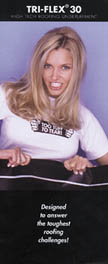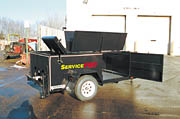Editor's Choice Products and Productivity
The roofing market is constantly being tempted with “new and better” equipment, materials and systems. Most try to make better and more productive use of the people part of the roofing equation, but some simply seek to deliver a better product without regard to productivity issues. Either way, we just wanted to make note of some new (or not-so new) and emerging materials, systems and equipment that are vying to become the next great thing in the roofing industry. Or at least great enough to become a mainstream product in the business.
These products were chosen for a wide variety of reasons, as you will see. They do not, however, reflect every great new thing in the business. If your favorite is missing, drop us a line and we will have a look for review in a future issue.
A Paper Solution
A couple of offerings we have seen lately are not new products at all, but are products presented in some new and unique ways. For instance, if you sell commercial roof insulation, you should check out a brochure published by the Polyiso Manufacturers Association (PIMA). It is a simple, four-page, four-color glossy brochure that details a study by the Energy Services Provider Group with the support for the Alliance for the Polyurethanes Industry. The study states in simple terms how much money you save in your energy costs by installing additional amounts of polyiso insulation. Separate studies are outlined covering retail buildings or elementary schools in selected cities across the country.
A recent survey by Roofing Contractor and Building Operating Management magazines (see Roofing Contractor, February 2002) showed that owners want good information on energy performance and have an appreciation for “value engineered” solutions. This brochure simplifies at least one part of the selection process and can result in a better system for the owner, and an increased contract for the roofing contractor.
Thanks, Wal-Mart
Any number of roofing contractors, and even a few manufacturers and suppliers, can thank the robust construction schedule kept by retailer Wal-Mart. The company has made a name for itself in retail and retail distribution by employing innovative solutions while bringing a vast array of products to a broad and demanding market. A big part of the job involves owning and managing a tremendous real estate portfolio, which includes many, many squares of low-slope roofing.The rest of us can now thank Wal-Mart for inspiring or instigating some solutions to problems that occurred on their buildings. One problem that cropped up for Wal-Mart in its many locations was the addition of roof-mounted satellite dishes. There were mixed results from the many different flashing methods employed around the country on different types of roofing systems. Wal-Mart settled on a solution with manufacturer Chem Link Inc., which provides a flashing system that includes everything necessary to fashion a workable penetration seal on every location, and on every roofing system.
Chem Link offers several (one-part and two-part) pourable sealers that are the heart of its patented ChemCurb system. The reason this product can be found anywhere goes to the company’s claim that the product is flexible to minus 40 degrees F, is composed of 100-percent solids (does not shrink), and is solvent free (compatible with styrofoam). ChemCurb is approved for use with a number of manufacturers’ systems, and is available with a 10-year, leak-proof warranty.
Many Wal-Mart stores have roof-mounted HVAC units as well. Lots of them. Condensate was causing a variety of problems on some roofing systems and roofing contractor C. Ross Dutton of Sackit Inc., Houston, came up with a patented solution for them. Engineered and manufactured by Johns-Manville, the AquaVert ™ system protects the surface of the roof system by controlling the path of AC condensation.
At the rooftop unit, the system starts with a 36-inch-wide catch area that funnels down to 8 inches in roughly 5 feet where it joins the 8-inch-wide AquaVert channel. The channel is fabricated with a fleece-backed PVC, which allows the product to be installed on a variety of roofing membranes, including BUR, MB, TPO, PVC and EPDM. AquaVert is a non-penetrating system and can be applied over existing roofing systems, or used in new-construction applications.
AquaVert would make a nice addition to many retrofit roofing projects, and may even provide an opportunity for contractors to install well in advance of a reroof to extend the life of an existing membrane. Johns-Manville and Sackit Inc. both market AquaVert.
Strange Bedfellows
Here’s a twist for you: a firm engaged in the pre-engineered metal building business in a joint-venture to market buildings with a major single-ply roofing manufacturer. VP Buildings and Firestone Building Products Co. have announced “an important innovation in the metal building and roofing industries.” “Deck-Frame” is a new product that will allow contractors to construct a pre-engineered metal building designed to handle membrane roof construction, an option VP claims has never before existed. If it ever did, it was a fairly well-kept secret.
Roofing contractors who may not have previously engaged with pre-engineered building contractors may wish to call around to learn more about this. Being from the roofing side of things, we all know the aesthetic and practical advantages of membrane roofing systems. Seems the metal building boys are catching on as well.
This Jumbo Might Fly
No, wait, that was Dumbo. Either way, you need to have a look at the new “Jumbo” Royal Sovereign shingle from GAF Materials Corp. We couldn’t help but be intrigued by this concept. It’s a simple, traditional three-tab shingle design, but made to a dimension (17 inches by 40 inches with a 7 1/2-inch exposure) that now requires only 48 shingles to cover the same square as 80 traditional size (12 inches by 36 inches with a 5-inch exposure) shingles. Savings in nails and labor are obvious.
With residential roofing products, looks aren’t everything, but they are darn important. The Jumbo Royal Sovereign will give the homeowner another option, which may turn out to look better than a conventional three-tab in many situations, such as on steep roofs that are particularly expansive between transitions. It will take a while to ramp this product up, but be on the lookout for it on a roofing job near you.

Not Just Another Pretty Face
By now you have surely seen the ads with the beautiful blonde pulling on a piece of roofing membrane. You were just looking at the girl, weren’t you? The ads are placed by Flexia Corp., and the membrane being tugged on is its Tri-Flex ® 30 “high tech roofing underlayment.” Begun as a dry-in product for upscale roofing projects, Tri-Flex has gone mainstream as a favored dry-in on new construction and retrofit roofing jobs of all types.Tri-Flex 30 comes in a 10-square roll and weighs roughly half that of a 2-square roll of #30 ASTM asphalt felt. It is spunbounded polypropylene coated with a layer of UV-stabilized polypropylene on both sides to create a very durable, tough fabric that won’t rip or tear away from nails even under the strongest wind conditions. Besides being easy to carry, this unique dry-in product lays flat, can be exposed for up to three months, will not crack at low temperatures, won’t dry out, and is highly slip-resistant.
Why does all this matter? We’re only talking about the dry-in, right? You are right now, but if there is trouble in the future with the primary membrane, it is wise to use the very best underlayment (no matter whose product you choose) up front. After all, your costs of dry-in applied count not only the material, but the labor as well. This product boasts coverage in one roll of 10 squares weighing a quarter of a conventional dry-in felt. The girl may still be in the ad, but you really need to check what is in the roll.
Step Up
Every year it seems like we see another line of safety devices and roof jacks. One, however, comes across so simply, you can miss the beauty of it. ProVision Tools of Franklin, Tenn., boasts two tools for steep roofing, the “RoofBoot” and “Pivit” Ladder tool. The Pivit design came about by way of a painting contractor who had to routinely stage his ladder or scaffold on a steep roof. It can be used on the roof or ground as a leveling device for a ladder, or used in conjunction with the “RoofBoot,” which is a roof jack designed to work both with the Pivit, with a ladder, or as a conventional roof jack. These are simple but effective tools to provide an essential margin of safety when working on the slopes.GPS in Roofing?
Contractors who work over wide geographic areas, or dispatch a large number of fleet assets even over a small area may want to consider a Global Positioning Satellite (GPS) tracking system to keep in touch with what is going on in the field. Some new GPS solutions have come along that are easy to use and are more affordable than ever.The typical GPS solution has a sending unit mounted in each vehicle in the fleet that tracks where the vehicle goes. The information is either stored for later retrieval, or sent back constantly for real-time monitoring. These devices also may be used to monitor vehicle speed, number and frequency of stops, idle time, and even opening and closing of doors. Owners who use this type of vehicle tracking seek to regain their investment by managing their assets more accurately, facilitating routing and dispatch, and improving fuel consumption.
Fleet ASAP is a “Mobile Resource Management” application by @Road. It is an Internet-based solution used to track movement of fleet assets. This service provides all location, dispatch, reporting and messaging for any size fleet 24/7/365. The service is known as a “live” system because it provides real-time data using the GPS system. Live systems require an investment in computer and truck mounted hardware and software and have a recurring fee for full-time “online” service.
FleetBoss is a system that consists of a vehicle-mounted GPS unit, which has either a “local” sending unit that stores vehicle data full time — but only downloads data when the unit returns to the home base — or can be configured with a “dial-up” option to gather real-time data. In the offline version, drivers leave the yard and the FleetBoss device records all their movements, speed, etc. On re-entering the yard at the end of the shift, the truck-mounted unit (which knows when it is back in the yard) sends the day’s worth of data to a PC-based receiver located in the office. When the sending unit receives confirmation that the data has been received, it “dumps” the day’s data and is ready to start a new day.
Placing GPS in fleet vehicles does require some training, but mostly it requires a good explanation to the people who drive the vehicles. This is more than “Big Brother,” is designed to assist in improving fuel mileage, dispatch and safety. Other options, such as mapping and routing, may be used with these systems. The bottom line, however, is very simple: “If you were riding around with each of your trucks every day, would they be operated more efficiently and safely?”

More Than a Kettle
We have had a lot to say lately about the wisdom of mounting a serious repair and maintenance effort as part of your overall roof contracting business. Roof maintenance can be a viable part of any roofing company’s offerings and is great to bridge those times when business slows, as well as providing a great service to existing clients and for finding new ones.Garlock Equipment Company of Minneapolis, Minn., has been in the roofing equipment business since there was a roofing equipment business. They offer all kinds of kettles, hoists, sprayers, deck equipment, re-roof equipment, and the list goes on. A recent introduction is a variation of something that came along back in the 1930s or 40s — not sure which, it was a long time ago — a skid-mounted, immersion-tube fired 115-gallon kettle.
Garlock’s 115 ServicePro Repair Kettle has the kettle mounted at the rear of a utility trailer specifically designed to carry roofing materials and tools to make BUR or MB roofing repairs. This unit is slick, good-looking, and can be towed safely by a conventional pick-up truck. When this combination pulls up on the job, it provides a considerably more modern look than a pick-up with a conventional kettle. When you are out doing repair work, looks do count. Garlock has thought of everything, right down to a place to secure cartons of asphalt and LPG tanks, and a removable drip pan for mops and brushes.
What’s Next?
It is interesting in our business that most great new ideas come from roofing contractors. Most of the patents mentioned in this article are held by roofing contractors. Mr. Garlock was a roofing contractor (several generations back) when he started making and selling roofing equipment. Chances are, the inventor of the next great thing is a roofing contractor reading this article right now. If you have something, we would sure love to hear about it!Looking for a reprint of this article?
From high-res PDFs to custom plaques, order your copy today!





